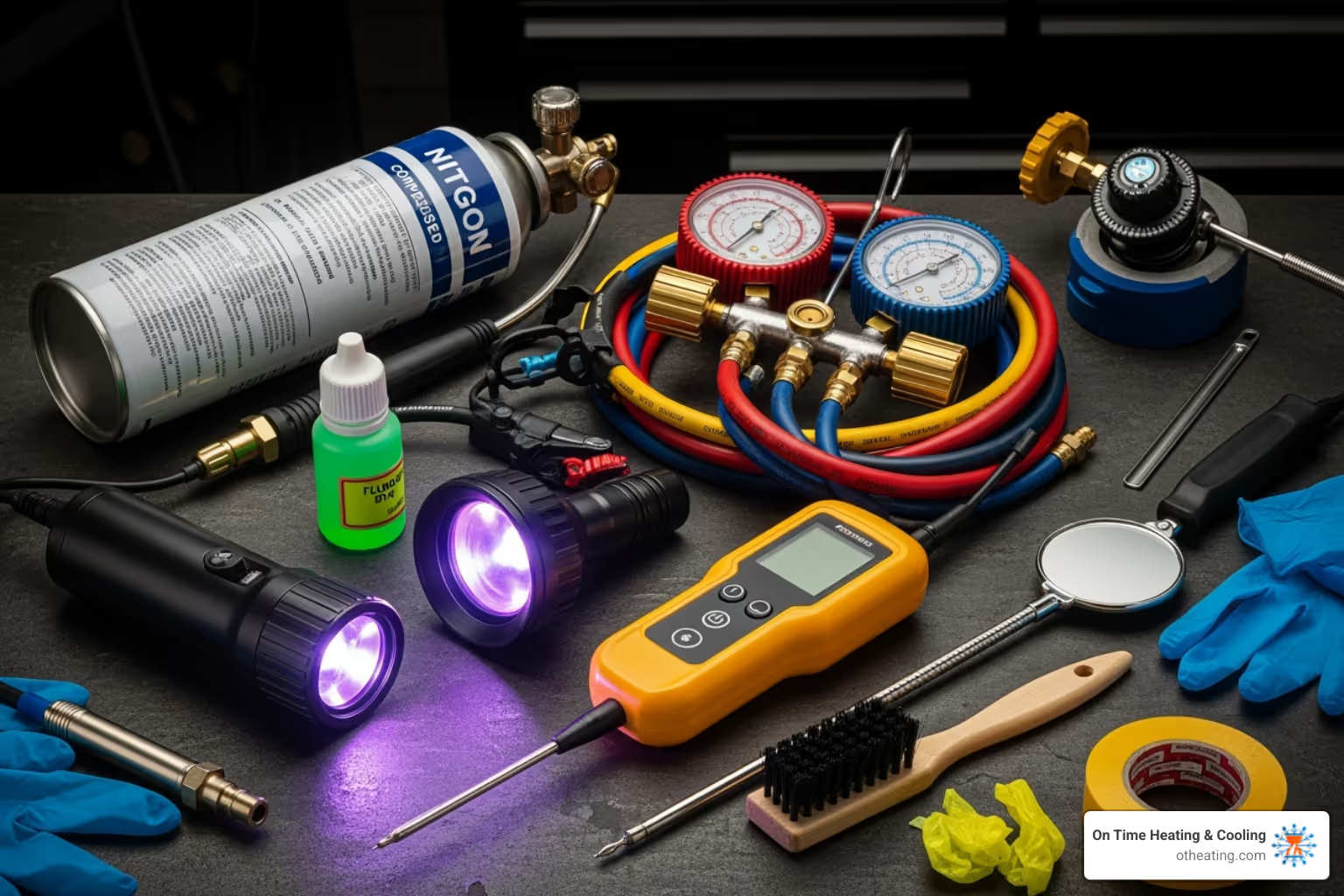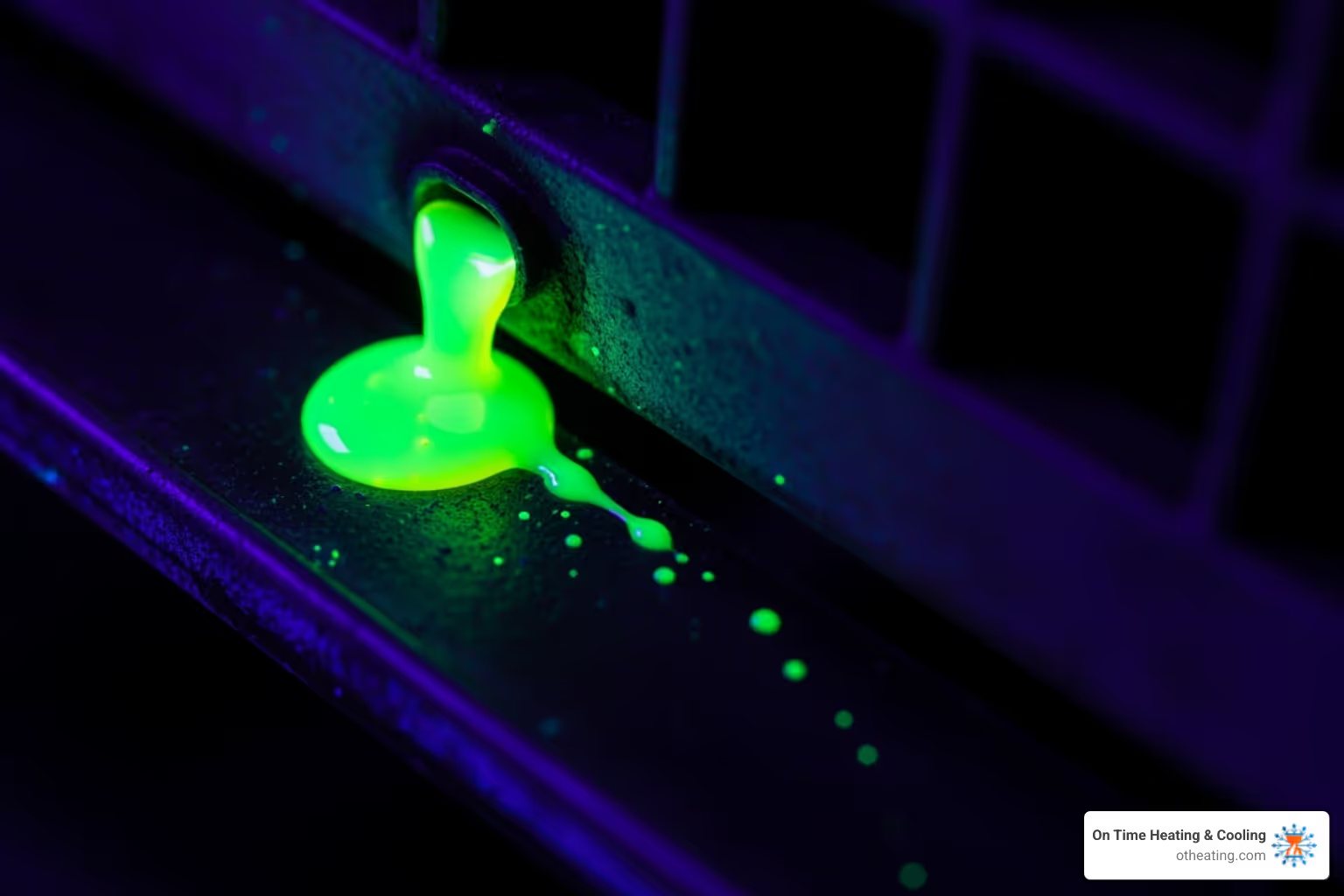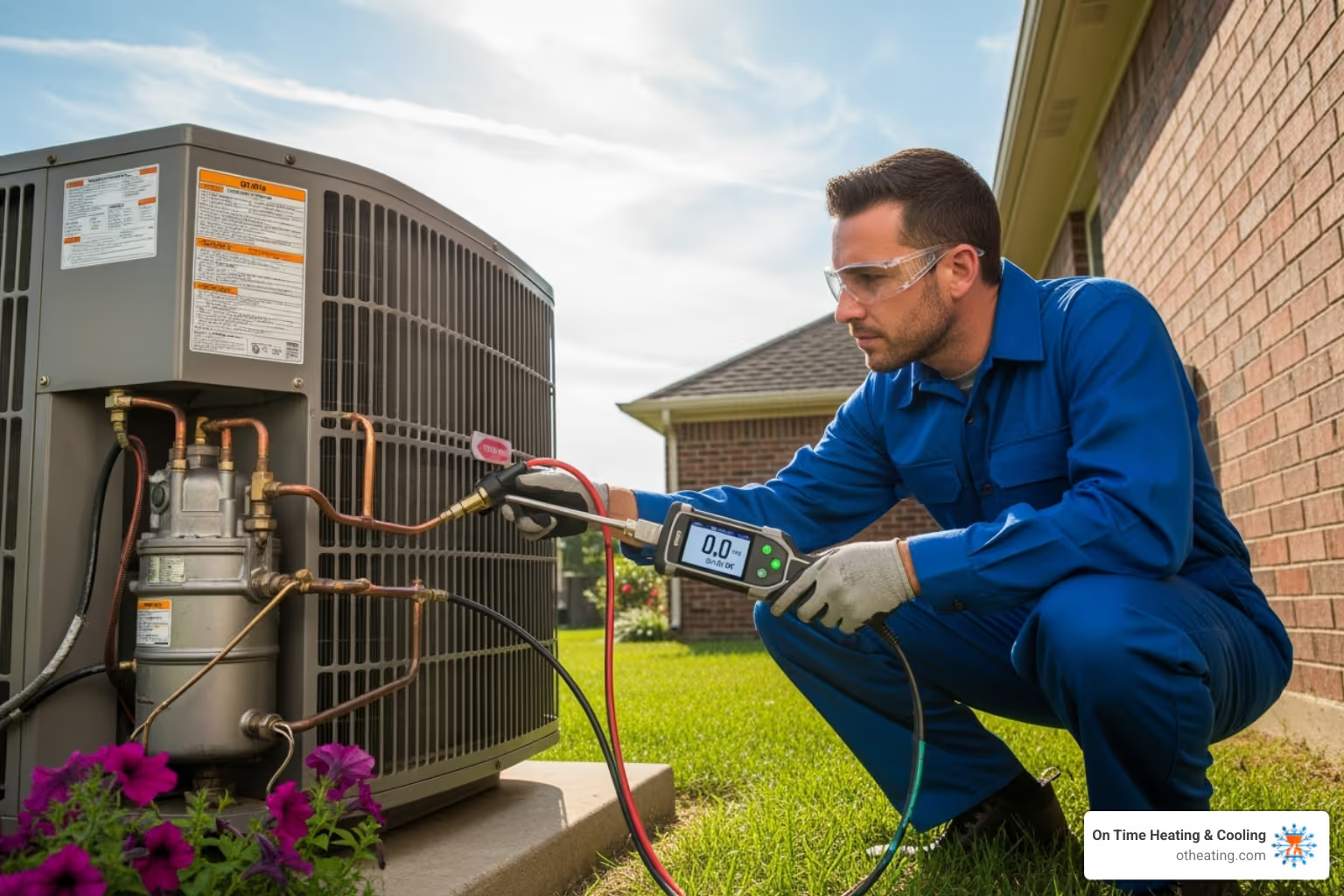
Finding AC Refrigerant Leaks: A Detective's Guide
Why AC Refrigerant Leak Detection is Critical for Your Home
AC refrigerant leak detection is essential for your air conditioner's efficiency and longevity. A refrigerant leak leads to reduced cooling, higher energy bills, and potential component failure. Key signs include ice on coils, oily residue, hissing sounds, warm air from vents, and increased humidity.
Your AC relies on refrigerant to move heat from your home to the outside. Modern systems contain as little as 20 ounces or less—much less than older units. This means even a small leak of just two ounces can cause serious problems.
A leak doesn't just affect your comfort; it hits your wallet through higher electricity bills and risks damaging the expensive compressor. Furthermore, refrigerant leaks harm the environment and violate EPA regulations.
Finding these leaks can feel more like an art than a science due to the complexity of modern systems. However, with the right knowledge, you can spot the warning signs early and take action before minor issues become major repairs.

The Telltale Clues: Recognizing the Signs of a Refrigerant Leak
Your air conditioner provides clear clues when something is wrong. AC refrigerant leak detection begins with recognizing these warning signs.
The most obvious sign is that your home isn't getting cold enough, with warm air blowing from your vents. Listen for a hissing or bubbling sound near the AC unit, which indicates escaping refrigerant.
Surprisingly, ice forming on your evaporator coils signals a cooling problem. When refrigerant is low, the pressure inside the coil drops, causing it to freeze. You might see ice on the coil or the connected lines.
Other signs include high indoor humidity, as the system can no longer effectively dehumidify the air, and increased electricity bills from the AC working overtime. Finally, look for a dark, oily residue around refrigerant lines and connections, which is lubricating oil that escapes with the refrigerant.
If these signs are familiar, it's time to investigate. For a complete overview, see our guide on Common AC Problems.
Common Causes of Leaks
Understanding why leaks occur can help with prevention.
- Vibrations from normal operation can gradually loosen connections over time.
- Natural wear and tear degrades rubber seals and metal components after years of temperature changes and operation.
- Corrosion on copper refrigerant lines, especially on the moisture-prone evaporator coils, can create pinhole leaks.
- Physical damage to the outdoor unit from lawnmowers, hail, or falling branches can puncture delicate coils and lines.
- Factory defects, while rare, can include weak welds or faulty seals that cause leaks later on.
- Improper installation or repairs, such as loose fittings or kinked lines, are a common source of preventable leaks. This is why choosing experienced professionals is so important.
Your Detective Toolkit: Methods for AC Refrigerant Leak Detection
Once you've spotted the clues, the next step in AC refrigerant leak detection is using the right tools. While some basic methods are homeowner-friendly, pinpointing elusive leaks requires professional equipment.

The Electronic Sniffer: How Electronic Detectors Work
The electronic leak detector, or "sniffer," is an HVAC technician's best friend. These handheld devices can sense tiny amounts of refrigerant in the air.
- Heated diode sensors are the industry workhorses. They heat a ceramic element that reacts when refrigerant molecules pass over it, triggering an alarm. They can detect leaks as small as 0.006 ounces per year.
- Infrared (IR) sensors use infrared light to identify refrigerant molecules. They are highly accurate and less prone to false alarms from other chemicals.
- Corona discharge sensors use a high-voltage field to detect refrigerant, but can sometimes be triggered by other airborne contaminants.
Electronic detectors are fast and sensitive, but their accuracy can be affected by wind or other fumes. For homeowners dealing with suspected leaks, our guide on How to Address AC Refrigerant Leaks at Home offers practical next steps.
The Visual Approach: Using UV Dye and Bubbles
Sometimes, the best detection methods are visual.
UV dye injection is a clever technique for finding stubborn leaks. A fluorescent dye is added to the refrigerant and circulates through the system. The dye escapes with the refrigerant at the leak point and glows brightly under a UV blacklight, pinpointing the exact location.

The soap bubble method is a classic DIY approach. A soap and water solution is applied to suspected connections. If refrigerant is escaping, it will form visible bubbles. This works well for larger, accessible leaks but won't find microscopic ones.
Advanced Techniques: Ultrasonic and Tracer Gas Detection
For the most difficult leaks, professionals use advanced AC refrigerant leak detection tools.
Ultrasonic detectors don't smell refrigerant; they listen for the high-frequency hissing sound of gas escaping through a tiny hole. This method is excellent in noisy environments but can be hampered by wind.
Tracer gas detection is a cutting-edge method where a safe mixture of hydrogen and nitrogen is added to the system. A specialized detector, like the one from Robinair, then sniffs for the tiny hydrogen molecules. This technique is incredibly accurate and can find the smallest leaks, even in an empty system.
The Investigation: A Step-by-Step Guide to Finding a Leak
Once a leak is suspected, the real AC refrigerant leak detection work begins. While we always recommend calling professionals, understanding the process helps you know what to expect.

Safety First: Handling Refrigerants and Detection Tools
Safety is paramount when dealing with refrigerants. This is not a DIY job due to significant risks.
- Frostbite: Liquid refrigerant is extremely cold and can cause severe frostbite-like burns on contact with skin or eyes. Professionals wear safety glasses and gloves.
- Inhalation: Breathing concentrated refrigerant vapor can cause dizziness, heart palpitations, and even asphyxiation by displacing oxygen. Medical experts at WebMD warn of these symptoms. Proper ventilation is mandatory.
- Electrical Shock: AC systems contain high-voltage components. Power to both indoor and outdoor units must be shut off at the breaker before any inspection.
A Technician's Process for Effective AC refrigerant leak detection
When our technicians arrive for AC refrigerant leak detection in Menomonee Falls and surrounding areas, we follow a systematic process.
After ensuring the system is safely powered down, we start with a thorough visual inspection. We look for the telltale oily residue on coils, pipes, and fittings, which is a strong indicator of a leak's location.
Next, we use a sensitive electronic leak detector to methodically scan the entire system. We pay close attention to common failure points:
- The evaporator coil (indoor unit), where corrosion often occurs.
- The condenser coil (outdoor unit), which is exposed to the elements.
- Refrigerant line sets, especially at brazed joints and connection points.
- Schrader valves and service ports, which are common sources of small leaks.
Finding a leak requires patience and precision. Some leaks only appear under specific operating pressures or temperatures. If an initial search is inconclusive, we may use UV dye and return for a follow-up inspection. Our goal is to pinpoint the exact source accurately and efficiently. For more on our process, see our guide to AC Repair Process Peak Performance.
Calling in the Pros: Why Professional Help is Crucial
While a DIY fix might seem tempting, AC refrigerant leak detection and repair should be left to professionals. A certified technician brings the required training, specialized tools, and experience to do the job safely and correctly.
Legally, only technicians with EPA 608 certification can handle refrigerants. This work involves more than just fixing the leak; it requires proper evacuation, recovery, and recharging of the system to protect the environment and prevent damage to your AC's compressor. One mistake can lead to costly failures.
When you call On Time Heating & Cooling, you get an expert who can accurately diagnose the problem and advise whether a repair or replacement is the smarter financial decision. Learn more about our AC Repair Services by Our Technicians.
The Environmental and Financial Cost of Ignoring an AC refrigerant leak
Ignoring a leak has serious consequences for both the environment and your finances.
Environmentally, refrigerants are potent greenhouse gases. Older types like R-22 deplete the ozone layer, while newer ones like R-410A have a Global Warming Potential (GWP) thousands of times higher than carbon dioxide. The EPA Clean Air Act makes it illegal to knowingly vent these substances.
Financially, a leaking system works harder, leading to higher energy bills. The worst-case scenario is compressor failure. Refrigerant lubricates the compressor, and when levels are low, it can overheat and burn out. Replacing a compressor is one of the most expensive AC repairs you can face.
Prevention is the Best Cure: The Role of Regular Maintenance
The best way to deal with leaks is to prevent them. Regular, professional maintenance is your first line of defense.
During an annual tune-up, our technicians conduct a thorough inspection of refrigerant lines, coils, and connections, looking for early warning signs like corrosion or loose fittings. We clean coils to improve efficiency and prevent corrosive buildup, and we check electrical connections to reduce stress on components. Catching these issues early turns major potential failures into minor, inexpensive repairs, significantly extending your system's lifespan.
For comprehensive care that keeps your system running smoothly, explore our AC Repair services.
Frequently Asked Questions about AC Refrigerant Leaks
We get many questions about AC refrigerant leak detection and repair. Here are answers to the most common ones.
Can I just add more refrigerant to my AC?
No. An air conditioner is a closed-loop system. If it's low on refrigerant, it always means there is a leak. Simply "topping it off" without fixing the leak is a temporary fix that is illegal under EPA regulations. It allows harmful refrigerant to continue leaking into the atmosphere and puts your AC's compressor at risk of failure.
How much does it cost to fix a refrigerant leak?
The cost varies widely depending on the leak's location and severity. A simple repair on an accessible line is relatively inexpensive. However, a leak in a hard-to-reach component like the evaporator coil can be much more complex and costly to fix. A professional diagnosis is necessary to get an accurate estimate. We provide transparent quotes after thoroughly assessing the situation.
Is a refrigerant leak dangerous?
Yes, a refrigerant leak can be dangerous. While the risk in a well-ventilated home is low, there are serious hazards:
- Health Risks: Inhaling concentrated refrigerant can cause dizziness, heart palpitations, and, in enclosed spaces, even asphyxiation by displacing oxygen.
- Frostbite: Direct contact with liquid refrigerant as it escapes a pressurized system can cause severe, instantaneous frostbite on the skin or in the eyes.
- Environmental Harm: Refrigerants are harmful to the environment, contributing to ozone depletion and climate change.
If you suspect a leak, turn off your AC and call a professional. Our team at On Time Heating & Cooling has the training and equipment to handle the situation safely.
Conclusion
AC refrigerant leak detection is like solving a mystery where the clues—warm air, frozen coils, hissing sounds—point to a problem that needs immediate attention. We've explored the signs, the causes like wear and corrosion, and the professional tools used to find leaks, from electronic sniffers to UV dyes.
The most critical takeaway is that this is not a DIY job. Handling refrigerants is dangerous, requiring certified professionals to ensure safety, protect the environment, and prevent costly damage to your system. Ignoring a leak leads to higher bills and eventual compressor failure.
At On Time Heating & Cooling, we understand the urgency of a broken AC. We show up on time, every time, with the expertise to solve your cooling crisis. Our team serves Menomonee Falls, Brookfield, Delafield, Pewaukee, Sussex, Waukesha, and communities throughout Southeast Wisconsin, blending old-school customer service with modern technical skill.
Regular maintenance is your best defense. Our tune-ups can catch potential leaks early, saving you money and ensuring your comfort.
Don't let a small leak become a major expense. For expert AC repair in Waukesha and the surrounding areas, contact our certified team today!

%202%20(1).svg)
.svg)

.svg)
.svg)
.svg)

.svg)